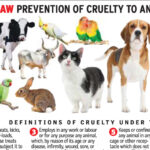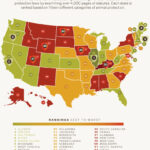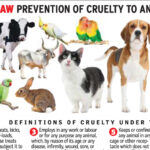Animal cruelty is a grievous affront, a stain on the tapestry of our shared existence with the sentient beings that inhabit our planet. It transcends the physical, intertwining with ethical dilemmas, societal values, and the very essence of empathy. But, what precisely constitutes animal cruelty? It is far more complex than mere physical harm, and all too often, the guidelines distinguishing humane treatment from neglect or abuse are obscured by cultural norms and individual misconceptions. Herein lies a comprehensive examination, illuminating fifteen surprising examples of animal cruelty that merit our immediate attention and understanding.
1. **Neglect and Abandonment**: A malaise that permeates many communities, neglect manifests as the want of basic necessities such as food, water, shelter, and veterinary care. Abandonment, the cruel severing of companionship, is a profound betrayal that leaves animals vulnerable to starvation, disease, and predation. Picture a dog, once a cherished companion, now wandering the streets in search of sustenance—a lost soul adrift in the tempest of human apathy.
2. **Overbreeding**: This horrific practice, often observed in the pursuit of profit, leads to the incessant production of offspring, resulting in numerous puppies and kittens condemned to lives of suffering in overcrowded shelters. Such relentless breeding turns breeding facilities into veritable prisons, where the innocent are viewed as mere commodities rather than living beings.
3. **Inadequate Living Conditions**: Even among those who consider themselves animal lovers, the subpar conditions in which pets are kept can amount to cruelty. Being forced to live in cramped quarters, such as a small cage or an unsanitary environment, diminishes an animal’s quality of life to near nothingness. Like a butterfly trapped in a glass jar, their potential remains unfulfilled in a space that stifles their spirit.
4. **Use of Confinement or Restraints**: The practice of keeping animals tethered for extended periods is not simply an inconvenience; it often results in physical and psychological harm. An animal confined to a small space or restrained by a chain is akin to a bard imprisoned, their song silenced, their vitality crushed beneath the weight of their chains.
5. **Lack of Socialization**: Animals are social creatures by nature. Denying them the opportunity to interact with others of their species or with humans engenders profound loneliness. Imagine the silence in the heart of an otherwise spirited creature, reduced to mere existence without companionship. This is a cruelty that echoes in the void of their social needs.
6. **Physical Abuse**: The most visible form of animal cruelty manifests in direct physical harm. Be it hitting, kicking, or other forms of violence, these acts wield unfathomable consequences and leave indelible scars—both visible and invisible. An animal suffering at the hands of a perpetrator feels not only the sting of impact but also the devastation of shattered trust.
7. **Exploitation for Entertainment**: The exploitation of animals for entertainment—be it in circuses, zoos, or other venues—often means they are subjected to rigorous training, unnatural behaviors, and confinement. The majestic elephant dancing under a spotlight is far removed from its wild ancestors, imprisoned in a gilded cage that borders on tragedy.
8. **Animal Testing**: The use of animals in scientific experimentation yields a plethora of ethical questions. Animals subjected to experimentation often experience excruciating pain, and their suffering is overlooked in the relentless pursuit of human advancement. The price of knowledge should not come at the expense of sentient life. It parallels a symphony where the melody is derived from dissonance and discord.
9. **Neglect of Medical Needs**: Animals require medical attention, just as humans do. Neglecting their health needs, whether for vaccinations or treatment of injuries, is a form of cruelty rooted in ignorance or indifference. A pet suffering from a heart condition without care is reminiscent of a melody played on a broken instrument, aching for restoration yet unheard.
10. **Trophy Hunting**: The act of hunting animals for sport—especially endangered species—reflects a profound disconnection from nature. The pursuit of a trophy is an antithesis to respect for life, treating sentient beings as mere accolades, draped on walls like tarnished medals of egregious conquest.
11. **Excessive Breeding for Aesthetic Qualities**: The overemphasis on certain physical traits in breeds, often at the expense of the animal’s health, can lead to severe genetic disorders. The breeding of Persian cats with flat faces often results in breathing issues, deformities, and shortened lifespans, rendering an ostensibly cherished breed a tragic illustration of beauty’s tyranny.
12. **Invasive Treatment**: Some individuals may subject their pets to unnecessary surgical procedures purely for aesthetic enhancement. Such practices not only disregard the animal’s discomfort but also compromise their very health. Picture a pristine canvas marred by unwarranted strokes, each incision a testament to misguided intentions.
13. **Use in Blood Sports**: Animals forced into combat, such as in dog fighting or cockfighting, are reduced to mere pawns in a game of violence. These brutal spectacles are a harrowing negation of their existence, where life is wagered in an arena defined by blood and cruelty. The fight for dignity and survival is one no creature should be forced to undertake.
14. **Transport Abuse**: Animals subjected to inhumane transportation practices during long journeys often suffer from overcrowding, dehydration, and injury. The ordeal of travel, particularly in extreme weather without adequate shelter, transforms into a harrowing pilgrimage of suffering, where hope flickers like a candle in a gusty wind.
15. **Cultural Indifference**: In some cultures, practices that may be deemed barbaric elsewhere are regarded with indifference. This cultural relativism can normalize cruelty, allowing practices that subject animals to suffering to persist. The time we live in demands a recalibration of values, compelling us to redefine the parameters of compassion that should encompass all sentient beings.
In conclusion, the landscape of animal cruelty is multifaceted, often insidious, and deeply embedded in societal norms and practices. Understanding the myriad forms it takes is the first step toward forging a society that respects and values all living beings. Each example delineated here serves as a reminder of our collective responsibility; to be vigilant custodians of the voiceless. We must advocate for a world where kindness prevails over cruelty, a world in which every animal can flourish without fear or suffering, resonating with the harmonious beauty that nature intended.







